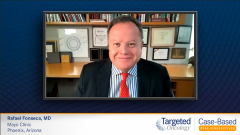
Novel CAR T-Cell Therapies for Relapsed/Refractory Multiple Myeloma
Shared insight on two novel CAR T-cell therapies, cilta-cel and ide-cel, that have been tested in multiply relapsed multiple myeloma.
Episodes in this series

Transcript:
Rafael Fonseca, MD: At the last ASH [American Society of Hematology Annual Meeting], Dr Thomas Martin from UCSF [University of California, San Francisco] presented the results of the CARTITUDE-1 study, which is BCMA-targeting CAR [chimeric antigen receptor] T cells. This is a phase 1b/2 study. We heard from previous presentations about the development of this construct and the very high rate of responses. At ASH, they present the data on close to 100 patients, so you have 97 patients who received ciltacabtagene autoleucel. This is a group of patients that had a median of 6 prior lines of therapy; the range was 3 to 18. These patients were extensively pretreated. About 85% of them were considered penta exposed, and 87% were triple-class refractory. So this is very advanced multiple myeloma, and the results are remarkable. The overall response rate that they report is 97.9%, but when you break it down, you’re going to see that 80% of patients have a stringent CR [complete response]. The results are really remarkable.
We started to see what’s happening with time and what’s happening with progression-free survival. The results are quite promising, and perhaps some of those patients will have a very durable—and we hope for some of them permanent—control of their disease. This is probably as exciting as it gets with clinical trials with multiple myeloma. Without a doubt, this is a clinical trial with the highest level of response that has ever been reported for multiple myeloma. But this has been tested in the more advanced disease. We’re hoping to see what the numbers are for earlier. A number of clinical trials that are going on and testing this. In fact, at ASH, the CARTITUDE-2 clinical trial was also presented with very similar results. As of February 2022, we have this product approved for the treatment of myeloma. Currently, it’s for patients who have similar characteristics as I described for this trial, so this is fairly advanced disease. But we’re all excited to have this as a new tool for the treatment of myeloma.
The other CAR T-cell construct, ciltacabtagene autoleucel, was presented in the New England Journal of Medicine in2021, as well as in updates at ASCO [American Society of Clinical Oncology Annual Meeting] Ciltacabtagene autoleucel targets BCMA and the surface of the cells with the range of doses. Between 150 and 450 million CAR T cells are infused back to the patients after lymphodepletion. This is another very active compound. This has been approved for a few months for the treatment of myeloma. Not as many patients have been treated, mostly because of the availability of the product. It’s still restricted, so we’re working our way through the ramping-up period, and we want many more patients to have access to this treatment. But when you look at the outcomes for our patients who have heavy prior treatment—the same median of 6 prior regimens, for the most part triple-class refractory—you still see an overall response rate of 73%.
There was a classic paper several years ago in which my colleague Keith Stewart suggested that any drug or intervention that has an overall response rate of 20% should be approved in myeloma. I just showed you 97%; this is 73%. About a third of these patients achieve a stringent complete response or a complete response. When you look at the highest dose of cell administration, which is 450 million cells, the overall response rate was 81% and CR was close to 40%. So the results are pretty remarkable.
These patients are at risk for cytokine release syndrome [CRS] and neurotoxicity, ICANS [immune effector cell-associated neurotoxicity syndrome]. But going forward, we realize that most of this is manageable in grade 1. There’s a growing body of literature of early and even preventive treatment for CRS. The same is true for neurotoxicity. My hope is that as we move into the future, we’ll learn more about how to use this type of construct, which is knowledge that is going to also expand into the bispecific antibody field. I’m very excited that we have it available. I wish we had more patients who we could be treating with this. But in the meantime, we’re seeing some very deep and quite durable responses. It’s possible that in the future we’ll better understand ciltacabtagene autoleucel and products like this and that they’ll continue to move forward. Perhaps they’ll even replace frontline therapy for patients who would otherwise be eligible for stem cell transplantation.
Transcript edited for clarity.









































